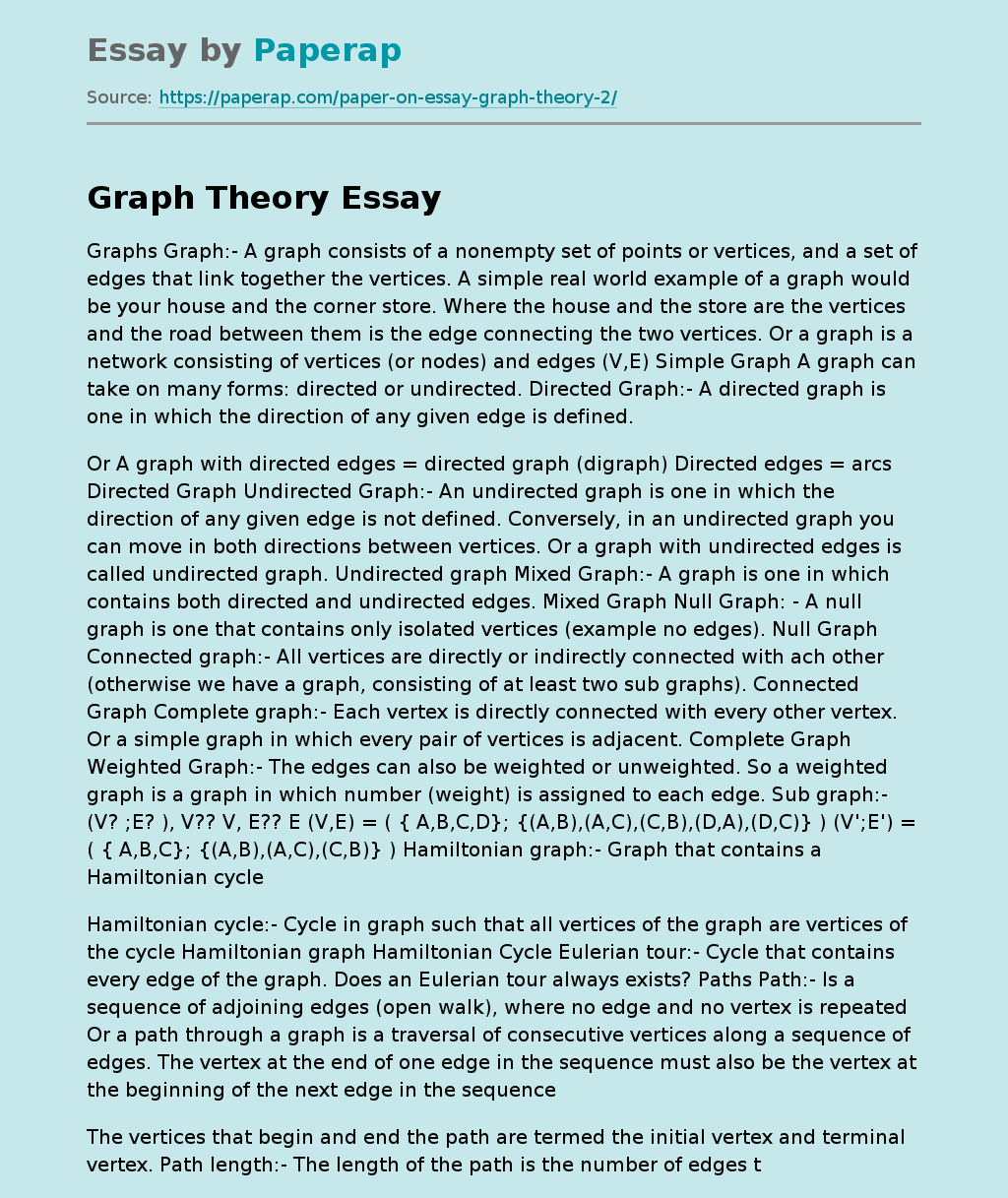Directed, Undirected, Mixed, Null, Connected, Complete, and Weighted Graphs
Graphs Graph:- A graph consists of a nonempty set of points or vertices, and a set of edges that link together the vertices. A simple real world example of a graph would be your house and the corner store. Where the house and the store are the vertices and the road between them is the edge connecting the two vertices. Or a graph is a network consisting of vertices (or nodes) and edges (V,E) Simple Graph A graph can take on many forms: directed or undirected.
Directed Graph:- A directed graph is one in which the direction of any given edge is defined.
Or A graph with directed edges = directed graph (digraph) Directed edges = arcs Directed Graph Undirected Graph:- An undirected graph is one in which the direction of any given edge is not defined. Conversely, in an undirected graph you can move in both directions between vertices. Or a graph with undirected edges is called undirected graph.
Undirected graph Mixed Graph:- A graph is one in which contains both directed and undirected edges. Mixed Graph Null Graph: – A null graph is one that contains only isolated vertices (example no edges). Null Graph Connected graph:- All vertices are directly or indirectly connected with ach other (otherwise we have a graph, consisting of at least two sub graphs). Connected Graph Complete graph:- Each vertex is directly connected with every other vertex. Or a simple graph in which every pair of vertices is adjacent. Complete Graph Weighted Graph:- The edges can also be weighted or unweighted.
So a weighted graph is a graph in which number (weight) is assigned to each edge. Sub graph:- (V? ;E? ), V?? V, E?? E (V,E) = ( { A,B,C,D}; {(A,B),(A,C),(C,B),(D,A),(D,C)} ) (V’;E’) = ( { A,B,C}; {(A,B),(A,C),(C,B)} ) Hamiltonian graph:- Graph that contains a Hamiltonian cycle
Hamiltonian cycle:- Cycle in graph such that all vertices of the graph are vertices of the cycle Hamiltonian graph Hamiltonian Cycle Eulerian tour:- Cycle that contains every edge of the graph. Does an Eulerian tour always exists? Paths Path:- Is a sequence of adjoining edges (open walk), where no edge and no vertex is repeated Or a path through a graph is a traversal of consecutive vertices along a sequence of edges. The vertex at the end of one edge in the sequence must also be the vertex at the beginning of the next edge in the sequence
The vertices that begin and end the path are termed the initial vertex and terminal vertex. Path length:- The length of the path is the number of edges that are traversed along the path. the length of the path in above example is 5. cycle:- is a path in which the initial vertex of the path is also the terminal vertex of the path. Walks walk :- is an alternating sequence of vertices and edges, beginning and ending with a vertex, where each vertex is incident to both the edge that precedes it and the edge that follows it in the sequence, and where the vertices that precede and follow an edge are the end vertices of that edge.
Open Walk:- A walk is open if its first and last vertices are different. Note:- A path referred to what is now usually known as an open walk. Closed Walk:- A walk is closed if its first and last vertices are the same, and open if they are different. Note:- A cycle traditionally referred to any closed walk. Walk Length:- The length l of a walk is the number of edges that it uses. For an open walk, l = n–1, where n is the number of vertices visited (a vertex is counted each time it is visited).
For a closed walk, l = n (the start/end vertex is listed twice, but is not counted twice). In the example graph, (1, 2, 5, 1, 2, 3) is an open walk with length 5, and (4, 5, 2, 1, 5, 4) is a closed walk of length 5. Forest:- Graph without cycles – not necessarily connected. Trees Tree:- Is a connected graph, where exactly one path from every vertex to any other one exists A tree with n vertices always has n–1 edges! Spanning tree:- is a subgraph of G, is a tree, and contains all the vertices of G Every connected graph contains a spanning tree.
Connected Graph Spanning Trees Minimum spanning tree:- is a spanning tree, but has weights or lengths associated with the edges, and the total weight of the tree (the sum of the weights of its edges) is at a minimum. Weighted Graph Minimum Spanning Tree Rooted tree:- Directed tree with a distinguished vertex, called the root, from which a directed path to every other vertex exists Depth:- of a rooted tree = max length of a path to the end node Rooted Tree
Directed, Undirected, Mixed, Null, Connected, Complete, and Weighted Graphs. (2019, Jun 20). Retrieved from https://paperap.com/paper-on-essay-graph-theory-2/

